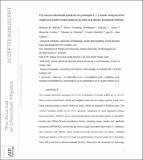Files in this item
The vacuum ultraviolet spectrum of cyclohepta-1, 3, 5-triene : analysis of the singlet and triplet excited states by ab initio and density functional methods
Item metadata
| dc.contributor.author | Palmer, Michael H | |
| dc.contributor.author | Vrønning Hoffmann, Søren | |
| dc.contributor.author | Jones, Nykola C | |
| dc.contributor.author | Coreno, Marcello | |
| dc.contributor.author | de Simone, Monica | |
| dc.contributor.author | Grazioli, Cesare | |
| dc.contributor.author | Aitken, R Alan | |
| dc.date.accessioned | 2020-08-04T09:30:02Z | |
| dc.date.available | 2020-08-04T09:30:02Z | |
| dc.date.issued | 2020-08-03 | |
| dc.identifier | 269185250 | |
| dc.identifier | eb7a01b6-4166-486b-bf0c-b14bb94ff68a | |
| dc.identifier | 85089261789 | |
| dc.identifier | 000559816100001 | |
| dc.identifier.citation | Palmer , M H , Vrønning Hoffmann , S , Jones , N C , Coreno , M , de Simone , M , Grazioli , C & Aitken , R A 2020 , ' The vacuum ultraviolet spectrum of cyclohepta-1, 3, 5-triene : analysis of the singlet and triplet excited states by ab initio and density functional methods ' , The Journal of Chemical Physics , vol. 153 , no. 4 , 054301 . https://doi.org/10.1063/5.0011088 | en |
| dc.identifier.issn | 0021-9606 | |
| dc.identifier.other | ORCID: /0000-0001-6959-5311/work/78527909 | |
| dc.identifier.uri | https://hdl.handle.net/10023/20403 | |
| dc.description.abstract | The vacuum ultraviolet (VUV) spectrum for cyclohepta-1,3,5-triene up to 10.8 eV shows several broad bands, which are compared with electron impact spectra. Local curve fitting exposed groups of sharp vibrational peaks, which are assigned to Rydberg states. The vertical excitation profile of the VUV spectrum, reproduced by time dependent density functional theory (TDDFT), gives a good interpretation of the principal regions of absorption. Fourth order Möller–Plessett perturbation theory, including single, double, and quadruple excitations, showed that the lowest singlet and triplet states retain CS symmetry. This contrasts with TDDFT where several low-lying excited states are planar. Detailed vibrational analysis of the first UV band was performed by Franck–Condon, Herzberg–Teller, and their combined methods. These show the dominance of mid-range frequencies, while the lowest frequency (75 cm−1) has negligible importance. In contrast, the second excited (Rydberg) state shows a major progression with separations of 115 (6) cm−1. This is interpreted by re-analysis of the X2A′ ionic state at the anharmonic level. Extremely low exponent Gaussian functions enabled several low-lying Rydberg state energies to be determined theoretically; extrapolation of the 3s-, 4s-, and 5s-Rydberg state calculated energies gives the adiabatic ionization energy as 7.837 eV (4) with δ 0.964 (2). Similarly, extrapolation of the centroids of the observed Rydberg states gave the vertical ionization energy (VIE) as VIE1 = 8.675 ± 0.077, close to the photoelectron spectroscopy VIE value [8.55 (1) eV]. | |
| dc.format.extent | 14 | |
| dc.format.extent | 5122456 | |
| dc.language.iso | eng | |
| dc.relation.ispartof | The Journal of Chemical Physics | en |
| dc.subject | QD Chemistry | en |
| dc.subject | NDAS | en |
| dc.subject.lcc | QD | en |
| dc.title | The vacuum ultraviolet spectrum of cyclohepta-1, 3, 5-triene : analysis of the singlet and triplet excited states by ab initio and density functional methods | en |
| dc.type | Journal article | en |
| dc.contributor.institution | University of St Andrews. School of Chemistry | en |
| dc.contributor.institution | University of St Andrews. EaSTCHEM | en |
| dc.identifier.doi | https://doi.org/10.1063/5.0011088 | |
| dc.description.status | Peer reviewed | en |
| dc.date.embargoedUntil | 2020-08-03 |
This item appears in the following Collection(s)
Items in the St Andrews Research Repository are protected by copyright, with all rights reserved, unless otherwise indicated.

